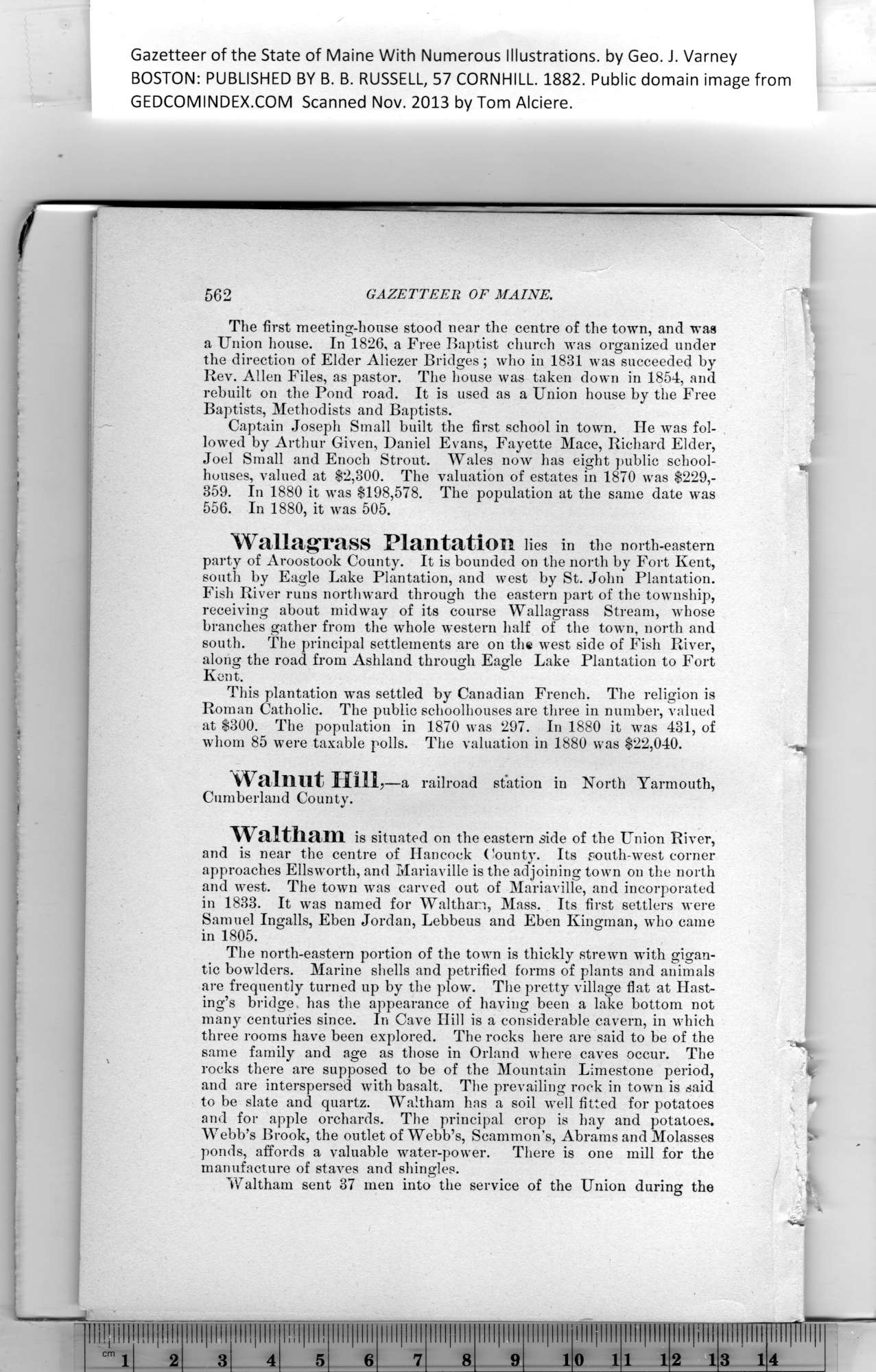|
Gazetteer of the State of Maine With Numerous Illustrations, by Geo. J. Varney
BOSTON: PUBLISHED BY B. B. RUSSELL, 57 CORNHILL. 1882. Public domain image from
562 GAZETTEER OF MAINE.
The first meeting-house stood near the centre of the town, and was
a Union house. In 1826, a Free Baptist church was organized under
the direction of Elder Aliezer Bridges; who in 1831 was succeeded hy
Rev. Allen Files, as pastor. The house was taken down in 1854, and
rebuilt on the Pond road. It is used as a Union house by the Free
Baptists, Methodists and Baptists.
Captain Joseph Small built the first school in town. He tvas fol-
lowed by Arthur Given, Daniel Evans, Fayette Mace, Richard Elder,
Joel Small and Enoch Strout. Wales now has eight public school-
houses, valued at $2,300. The valuation of estates in 1870 was $229,-
359. In 1880 it was $198,578. The population at the same date was
556. In 1880, it was 505.
Wall a^rass Plantation lies in the north-eastern
party of Aroostook County. It is bounded on the north by Fort Kent,
south by Eagle Lake Plantation, and west by St. John Plantation.
Fish River runs northward through the eastern part of the township,
receiving about midway of its course Wallagrass Stream, whose
branches gather from the whole western half of the town, north and
south. The principal settlements are on the west side of Fish River,
along the road from Ashland through Eagle Lake Plantation to Fort
Kent.
This plantation wras settled by Canadian French. The religion is
Roman Catholic. The public schoolhouses are three in number, valued
at $300. The population in 1870 was 297. In 1880 it was 431, of
whom 85 were taxable polls. The valuation in 1880 was $22,040.
Walnut Hill, —a railroad station in North Yarmouth,
Cumberland County.
Waltham is situated on tbe eastern side of tbe Union River,
and is near the centre of Hancock County. Its south-west corner
approaches Ellsworth, and Mariaville is the adjoining town on tlie north
and west. The town was carved out of Mariaville, and incorporated
in 1833. It was named for Waltham, Mass. Its first settlers were
Samuel Ingalls, Eben Jordan, Lebbeus and Eben Kingman, who came
in 1805.
The north-eastern portion of the town is thickly strewn with gigan-
tic bowlders. Marine shells and petrified forms of plants and animals
are frequently turned up by the plow. The pretty village flat at Hast-
ing’s bridge, has the appearance of having been a lake bottom not
many centuries since. In Cave Hill is a considerable cavern, in which
three rooms have been explored. The rocks here are said to be of the
same family and age as those in Orland where caves occur. The
rocks there are supposed to be of the Mountain Limestone period,
and are interspersed with basalt. The prevailing rock in town is said
to be slate and quartz. Waltham has a soil well fitted for potatoes
and for apple orchards. The principal crop is hay and potatoes.
Webb’s Brook, the outlet of Webb’s, Scammon’s, Abrams and Molasses
ponds, affords a valuable water-power. There is one mill for the
manufacture of staves and shingles.
Waltham sent 37 men into the service of the Union during the
PREVIOUS PAGE ... NEXT PAGE
This page was written in HTML using a program written in Python 3.2
|
